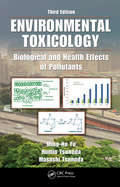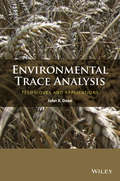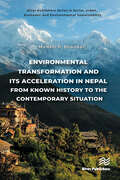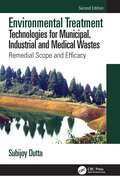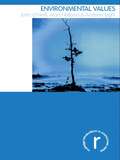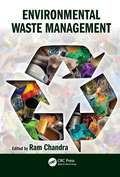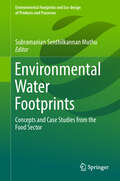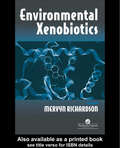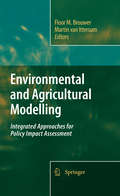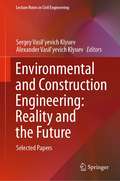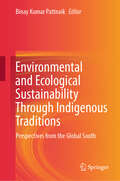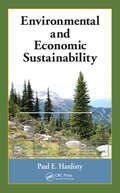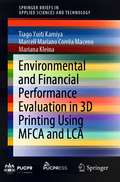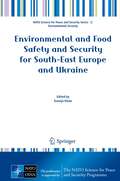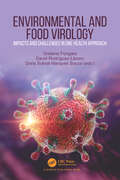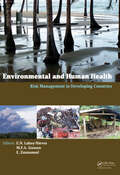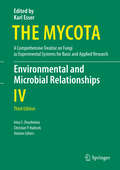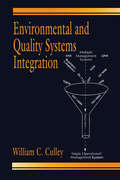- Table View
- List View
Environmental Toxicology and Ecosystem
by Ashutosh KumarThis book covers varied aspects of environmental contaminants and their effect on the living organisms. It addresses the basics of ecotoxicity assessment, interaction of the abiotic or biotic factors with the novel chemical entities, and the fate of the natural organic matter upon interaction with new chemical entities. It further includes models for ecotoxicity studies and high-throughput approaches including OMICS. It provides an overview of the ecological risk assessment, regulatory toxicology guidelines, and possible roadmaps for protection of environmental health. Features: Discusses environmental toxicology facets and their effects on the ecosystem. Provides an introduction of environmental toxicology keeping in view the paradigm shift on entry of novel materials in the environment. Includes bioavailability, bioconcentration, and biomagnification of trophic transfer of pollutants. Covers high-throughput approaches for ecotoxicity assessment. Explores roadmaps for environmental protection and sustainable development. This book is geared toward graduate students and researchers in Environmental Sciences and Engineering, Toxicology, and Ecology.
Environmental Toxicology and Toxicogenomics: Principles, Methods, and Applications (Methods in Molecular Biology #2326)
by Baohong Zhang Xiaoping PanThis detailed book provides an accessible compendium of up-to-date methods in the fields of environmental toxicology, molecular toxicology, and toxicogenomics. Organized into four major sections, the volume examines methods utilizing model animal species, such as nematode, fruit fly, mice, chicken, and amphibians, methods using plants to study chemical toxicity, applying the Ames assay to chemical mutagenicity study, as well as methods for environmental chemical analysis. Although this book is divided into these parts, the methods can be used across species. Written for the highly successful Methods in Molecular Biology series, chapters include introductions to their respective topics, lists of the necessary materials and reagents, step-by-step, readily reproducible laboratory protocols, and tips on troubleshooting and avoiding known pitfalls. Authoritative and practical, Environmental Toxicology and Toxicogenomics: Principles, Methods, and Applications serves as a valuable resource for the scientific community, particularly for young scientists and graduate and undergraduate students, inspiring more research in the vitally important field of environmental toxicity, molecular toxicology, and toxicogenomics.
Environmental Toxicology: Biological and Health Effects of Pollutants, Third Edition
by Ming-Ho Yu Humio Tsunoda Masashi TsunodaHuman survival depends on the availability of clean air, water, and food and on the welfare of plants and animals. However, anthropogenic and naturally occurring chemicals can cause adverse effects on living organisms and ecological processes. Environmental Toxicology: Biological and Health Effects of Pollutants, Third Edition presents fundamental
Environmental Trace Analysis
by John R. DeanThis book covers all aspects of environmental trace analysis from sampling through to preparation of the sample to the analytical techniques used to quantify the level of trace metals or organic compounds. The book is divided into two areas: sample preparation for inorganic analysis and sample preparation for organic analysis. This allows the reader to focus on key aspects related to the preparation of samples for their subsequent analysis. Selected case studies provide the reader with the opportunity to consider how the sample preparation approach can be optimized for their own area of expertise.
Environmental Transformation and its Acceleration in Nepal From Known History to the Contemporary Situation (River Publishers Series in Social, Urban, Economic and Environmental Sustainability)
by Medani P. BhandariThis is an in-depth exploration of Nepal’s environmental journey, tracing its transformation from ancient practices to modern sustainability challenges. Drawing from over four decades of experience as an environmentalist and humanitarian, Dr. Medani Bhandari takes readers through the historical, social, and ecological shifts that have shaped Nepal’s environmental landscape. This comprehensive work examines the complex interplay between traditional knowledge, policy development, and global environmental trends, offering valuable insights into the country’s past, present, and future.This is a critical resource for understanding the environmental challenges faced by Nepal, a country rich in natural resources but confronted with the pressing issues of deforestation, water scarcity, and climate change. By analyzing these challenges through the lens of history, politics, and social change, this book offers a holistic understanding of the forces at play and presents actionable solutions for moving forward.This work bridges the gap between academic research and practical, on-the-ground experience. It incorporates diverse perspectives, combining ecological science with policy analysis, and highlights the interconnectedness of environmentalism with social justice, cultural identity, and global sustainability. The book provides policymakers, researchers, NGOs, and environmental advocates with a framework for fostering sustainable practices that are both contextually relevant and globally applicable.Readers will see a detailed examination of Nepal’s environmental transformation, a roadmap for accelerating sustainable practices, and a call to action for local and global stakeholders. This book is an invaluable resource for anyone seeking to understand Nepal’s environmental evolution and the broader implications for sustainable development in the global context.Technical topics discussed in the book include:• Historical evolution of environmentalism in Nepal• Impact of traditional ecological knowledge on conservation practices• Deforestation and forest management strategies• Water scarcity and management challenges• Climate change impacts and adaptation in Nepal• Biodiversity conservation and protected area management• Sustainable agricultural practices and agroforestry• Environmental policy and legislation in Nepal• The role of NGOs and community-based conservation• The intersection of environmentalism, social justice, and equity
Environmental Transport Phenomena (ISSN)
by A. Eduardo Saez James C. BaygentsThis book offers a detailed yet accessible introduction to transport phenomena. It begins by explaining the underlying principles and mechanisms that govern mass transport, and continues by tackling practical problems spanning all subdisciplines of environmental science and chemical engineering. Assuming some knowledge of ordinary differential equations and a familiarity with basic fluid mechanics applications, this classroom-tested text addresses mass conservation and macroscopic mass balances, placing a special emphasis on applications to environmental processes and presenting a mathematical framework for formulating and solving transport phenomena problems.
Environmental Treatment Technologies for Municipal, Industrial and Medical Wastes: Remedial Scope and Efficacy
by Subijoy DuttaEnvironmental Treatment Technologies for Municipal, Industrial and Medical Wastes will provide the reader with a simple and clear path to analyze the full range of options to manage/treat any solid, hazardous, or medical waste problems/issues at hand. This book aims to disseminate information on available remediation treatment technologies to developing and developed countries. It also includes adequate information on all available treatment technologies for different types and categories of waste (hazardous, non-hazardous municipal solid waste, and medical waste). The technologies are grouped into the following categories: Containment technology; Soil washing; Thermal treatment; Vapor extraction; Bioremediation including Phytoremediation; Plasma/Incineration; Other Physical/Chemical treatments. It enlightens the effect of emissions during remediation activities on climate change and suggests measures to identify and control such emissions. It also covers the application of remote sensing technologies with examples and the impending issues of proper disinfection and disposal of COVID-19 related waste pertaining to the current pandemic. It is intended for almost anyone — ranging from college students and early career professionals interested in environmental pollution control, to graduate students, researchers and experienced professionals. This book will: cover several recent developments on various treatment technologies, including in situ applications and their emission/migration control methods including remote sensing technologies; deal with municipal solid waste, their treatment/disposal methods, recycling, and reuse in addition to the hazardous and medical waste management program; assist civil/environmental engineering students and local community organizations in evaluating the impact of an industry and its associated waste produced on-site; and cover how best to treat/manage the waste to arrive at a safe operation without impacting human health and the local environment.
Environmental Values
by Andrew Light John O'Neill Alan HollandWe live in a world confronted by mounting environmental problems; increasing global deforestation and desertification, loss of species diversity, pollution and global warming. In everyday life people mourn the loss of valued landscapes and urban spaces. Underlying these problems are conflicting priorities and values. Yet dominant approaches to policy-making seem ill-equipped to capture the various ways in which the environment matters to us. Environmental Values introduces readers to these issues by presenting, and then challenging, two dominant approaches to environmental decision-making, one from environmental economics, the other from environmental philosophy. The authors present a sustained case for questioning the underlying ethical theories of both of these traditions. They defend a pluralistic alternative rooted in the rich everyday relations of humans to the environments they inhabit, providing a path for integrating human needs with environmental protection through an understanding of the narrative and history of particular places. The book examines the implications of this approach for policy issues such as biodiversity conservation and sustainability. Written in a clear and accessible style for an interdisciplinary audience, this volume will be ideal for student use in environmental courses in geography, economics, philosophy, politics and sociology.
Environmental Waste Management
by Ram ChandraRapid industrialization has resulted in the generation of huge quantities of hazardous waste, both solid and liquid. Despite regulatory guidelines and pollution control measures, industrial waste is being dumped on land and discharged into water bodies without adequate treatment. This gross misconduct creates serious environmental and public health
Environmental Water Footprints: Agricultural and Consumer Products (Environmental Footprints and Eco-design of Products and Processes)
by Subramanian Senthilkannan MuthuThis book uses case studies to highlight the environmental water footprints in the agricultural and livestock farming sector, and those of consumer products. Water conservation is a major element of every industry’s sustainability strategy.
Environmental Water Footprints: Concepts And Case Studies From The Food Sector (Environmental Footprints And Eco-design Of Products And Processes)
by Subramanian Senthilkannan MuthuThis book discusses the concept of water footprint and corporate water footprint, presenting case studies on a thermal power plant in India and on the food sector. Water conservation is a key element of industrial sustainability strategies.
Environmental Xenobiotics
by Mervyn RichardsonThe effects of man-made substances (xenobiotics) on the natural environment are described in this volume. It explains why these effects need to be understood, monitored and curtailed, especially in developing countries.
Environmental and Agricultural Modelling:
by Martin Van Ittersum Floor M. BrouwerAgriculture increasingly faces the challenge of balancing its multiple functions in a sustainable way. Integrated assessment and modelling (IAM) can provide insight into the potential impacts of policy changes. However, concepts to address the wide range of issues and functions typical for agriculture are still scarce. Environmental and Agricultural Modelling reviews and presents our current understanding of integrated and working tools to assess and compute, ex-ante, alternative agricultural and environmental policy options, allowing: 1. Analysis at the full range of scales (farm to European Union and global) whilst focusing on the most important issues emerging at each scale; 2. Analysis of the environmental, economic and social contributions of agricultural systems towards sustainable rural development and rural viability; 3. Analysis of a broad range of issues and agents of change, such as climate change, environmental policies, rural development options, effects of an enlarging EU, international competition, and effects on developing countries.
Environmental and Construction Engineering: Selected Papers (Lecture Notes in Civil Engineering #160)
by Sergey Vasil’yevich Klyuev Alexander Vasil’yevich KlyuevThis book gathers the latest advances, innovations, and applications in the field of construction engineering, as presented by researchers and engineers at the International Conference Environmental and Construction Engineering: Reality and the Future, held in Belgorod, Russia, on May 18-19, 2021. It covers highly diverse topics, including industrial and civil construction, building materials; environmental engineering and sustainability; machines, aggregates and processes in construction. The contributions, which were selected by means of a rigorous international peer-review process, highlight numerous exciting ideas that will spur novel research directions and foster multidisciplinary collaborations.
Environmental and Ecological Sustainability Through Indigenous Traditions: Perspectives from the Global South
by Binay Kumar PattnaikThis book explores the environmental and ecological wisdom inherent in some of the indigenous traditions of traditional communities from developing societies like, Argentina, Brazil, India, Mexico, Sri Lanka, and Thailand. It throws light on how these discrete and unrecognized traditions have enabled communities to live in harmony with nature for ages. Despite the best efforts of the modern states through policy-making, intensive R&D for eco-friendly technologies and products, social and environmental impact assessment studies (SEIAS), and cost benefit analysis (CBA) of projects, environmental and ecological degradation continues, mostly in developing societies, which house large number of traditional communities. This book explores their traditions consisting of world views or cosmologies, eco-savvy-customs, indigenous knowledge systems involving community-based occupations and practices, skills and crafts, and so on. This book shows that when interpreted in consonance with scientific environmentalism, these traditions reveal their inbuilt environmental wisdom, mirroring sacredness of nature that have instilled built-in conservation practices, are key to sustainability.The conception of indigenous traditions that subsume environmental and ecological sustainability as well as cultural identity is studied in the book, from the vantage of multi-disciplinary perspectives. This book reflects two streams of thought : (i) stream of social anthropology, arguing for the inbuilt strength of indigenous traditions, that necessitate empathetic understanding with their own rights for recognition and survival, and (ii) stream of indigenous knowledge systems being technically effective only necessitate validation and certification by modern scientific knowledge system for wider use. The book is of great use to policy-makers and non-government players, in addition to researchers and academicians working in the area of sustainable development and indigenous / traditional communities.
Environmental and Economic Sustainability
by Paul E. HardistyNever before has the quest to balance the needs of people, the environment, and the economy been so important. While sustainability has been widely taken up by governments and business, the world has continued to move in increasingly unsustainable directions, from continued dependence on fossil energy to rising greenhouse gas emissions, and erosion
Environmental and Financial Performance Evaluation in 3D Printing Using MFCA and LCA (SpringerBriefs in Applied Sciences and Technology)
by Tiago Yuiti Kamiya Mariana Kleina Marcell Mariano Corrêa MacenoThis book presents the methodology of environmental and financial performance evaluation in 3D printing processes using the MFCA and LCA. This methodology is divided into 7 main steps, which are: a) identification of the analysis problem (for example, comparison of different types of 3D printer for use in a given purpose, comparison of different printing materials for the same 3D printer technology, among others) and definition of printing parameters; b) definition of the product to be printed; c) preparation of the printing process flow diagram; d) definition or measurement of the lifespan of the printed product; e) data collection for the implementation of the LCA tool (for example, mass and energy balances); f) data collection for the implementation of the MFCA tool (for example, mass balances, energy balances, mass costs, energy costs, labor costs, etc.); and g) comparative assessment of the financial and environmental performance of 3D printing. As a way of exemplifying the application of this methodology, a real case is presented involving the comparison of two types of materials (Polylactic Acid – PLA – and Polyethylene Glycol Polyterephthalate – PETG) used in the 3D printing process by FDM technology. The part printed in this real case was a clearance gauge used as a joint spacing control by an automobile industry located in Brazil. The development of the methodology and consequent application has shown that it can be used by users of 3D printing, in the most diverse areas, to support their decision in choices that can present the best performance, both financial and environmental.
Environmental and Food Safety and Security for South-East Europe and Ukraine
by Ksenija VitaleThis book covers important aspects of the field of food security and safety, ranging from fundamental production, through advanced water treatment technologies and detection of novel pollutants, to management and policy making. The discussion strives to develop an integrated approach to solving the associated problems by simultaneously considering sociological, ecological and economic aspects. Special focus is on the environmental management systems that should be integrated in the processes of environmental risk assessment. Also addressed are other technologies applied in the service of detecting, preventing and monitoring possible threats to food security and safety. With its variety of subjects, this volume can serve both as a textbook for advanced studies and as a useful reference source for professionals.
Environmental and Food Virology: Impacts and Challenges in One Health Approach
by Gislaine Fongaro David Rodr Doris Sobral Marques SouzaEnteric pathogenic viruses are a major challenge in public health, as they represent a major concern with a severe global impact to the economy, commerce, and health systems. Consequently, their active monitoring can allow preventive surveillance and the discovery of new viruses, exemplifying an important epidemiological and health control tool.In an unprecedented way, this book addresses the general characteristics of enteric viruses and their environmental transmission, with a particular emphasis on their structures, stability, routes of transmission and the use of bioindicators for epidemiological monitoring and control. In addition, this book will also address the recent developments for viral concentration and detection in environmental and food samples and the challenges for the control of environmental and food viruses to reduce microbiological risk for final consumers.
Environmental and Health Impact Assessment of Development Projects: A handbook for practitioners
by The World Health OrganizationThis handbook for practitioners in environmental and public health, environmental management, toxicology and ecotoxicology has been prepared by an international group of experts from both developing and developed countries and covers a wide range of topics in both environmental impact assessment and environmental health impact assessment.
Environmental and Human Health: Risk Management in Developing Countries
by Eddie N. Laboy-Nieves Mattheus F. A. Goosen Evens EmmanuelMany countries experience lack of harmony among economic development, environmental management and human health. As a consequence, public health, the integrity of ecosystems, and the efforts to reach environmental sustainability, have been adversely affected. The complexity, frequency and magnitude of those impacts is increasingly parallel to the t
Environmental and Microbial Relationships
by Christian P. Kubicek Irina S. DruzhininaThis volumeprovides insights into current research on fungal populations, communities andtheir interactions with other organisms. It focuses on fungal responses to thephysical environment; interactions with bacteria, other fungi, invertebratesand plants; the role of fungi in ecosystem processes such as decomposition andnutrient cycling; and aspects of biogeography and conservation. Since thepublication of the second edition of Volume IV in 2007, the massive use of"omics" methods has revolutionized our understanding of fungal lifestyles. Highlighting these advances, the third edition has been completely updated andrevised. Several chapters deal with various applications of genomics andtranscriptomics in biological pest control, as well as interactions with otherliving systems. This is an invaluable source of information both for scientistswho wish to update their knowledge of current advances and for graduatestudents interested in obtaining a comprehensive introduction to this field ofresearch.
Environmental and Natural Resources Economics
by Fan Zhang Xiangzheng Deng Zhihui Li Malin Song Yuexian LiuThis book aims to integrate multiple disciplinary such as management, economics, and geography from the perspective of resource science and also to strengthen research on resource management to promote sustainability in natural resources. It established clear definition of natural resources and in-depth exploration of main fields such as water resources, land resources, and agricultural resources. Classic methods of economics are applied to solve the problems of resource consumption, environmental pollution, and climate change in modern society. On the basis of classical economics, the disciplinary system of environmental and natural resources is further developed. It is a helpful reference for readers to further study natural resources and environmental economics.
Environmental and Natural Resources Engineering: Water Resources And Natural Control Processes (Handbook of Environmental Engineering #19)
by Lawrence K. Wang Yung-Tse Hung Nazih K. Shammas Mu-Hao Sung WangThis volume has been designed to serve as a natural resources engineering reference book as well as a supplemental textbook. This volume is part of the Handbook of Environmental Engineering series, an incredible collection of methodologies that study the effects of resources and wastes in their three basic forms: gas, solid, and liquid. It complements two other books in the series including "Natural Resources and Control Processes" and "Advances in Natural Resources Management". Together they serve as a basis for advanced study or specialized investigation of the theory and analysis of various natural resources systems.This book covers many aspects of resources conservation, treatment, recycling, and education including agricultural, industrial, municipal and natural sources. The purpose of this book is to thoroughly prepare the reader for understanding the available resources, protection, treatment and control methods, such as bee protection, water reclamation, environmental conservation, biological and natural processes, endocrine disruptor removal, thermal pollution control, thermal energy reuse, lake restoration, industrial waste treatment, agricultural waste treatment, pest and vector control, and environmental engineering education. The chapters provide information on some of the most innovative and ground-breaking advances in environmental and natural resources engineering from a panel of esteemed experts.
Environmental and Quality Systems Integration
by William C. CulleyGlobal competition, corporate downsizing and corporate restructuring have forced many firms to reevaluate their operating methods. Today, corporations must do more with less while still watching the bottom line and improving profitability. ISO 14000 and ISO 9000, because of their similar management system requirements and auditing procedures, are g


